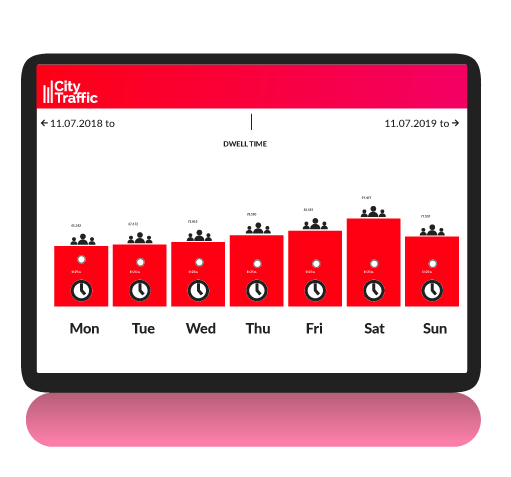What do we measure
CityTraffic has counted footfall, fully automated, in the main shopping streets of the Netherlands and Belgium, since 2010. Thanks to our advanced technology, we not only measure footfall, but also how many unique visitors there are in a shopping street, on average, dwell time and footfall flow. The average weekly footfall flow is also available, thanks to our technology.
Footfall measurement
CityTraffic has counted footfall at different locations in the Netherlands and Belgium, using advanced sensors, since 2010. The use of these sensors allows us to count footfall per half-hour accurately. Thanks to our innovative technology, we can also determine the number of unique visitors in an area, preventing double counting.

Read how the City of Alkmaar developed an effective city center policy based on CityTraffic data and critical insights of Bureau RMC
Number of visitors
The number of unique visitors is derived from the total footfall. How does this work? A MAC address, which gets picked up by our sensors, is anonymized by cutting it up. As an example, we use the following equation: a MAC address with number 00:0C:6E:D2:11:E6 is immediately converted to ‘Rotterdam’ by the software of the sensor. This word is sent to the server and changed to ‘Dam’. ‘Dam’ then refers to 4096 different possibilities. We determine a visitor by identifying whether ‘Dam’ is picked up again by the same or another sensor on that same day. There is a possibility that this is another device. This is the margin of error of our calculation. It does not refer back to individual devices in this way, but to a lot of devices. We make calculations of the number of double counts or the average timespan between two detections of the group ‘Dam’. This is how we determine the number of visitors or the exchange of visitors between sensor locations. We realize that this is an estimation. However, this gives you insight into the local purchasing power and how footfall develops in the city center. Completely privacy safe, without the risk of identification, the ability to link data or the ability to trace back to an individual.

Street Jump determined potential revenues in an area with the correct data and decided on a new location
De Kopermolen Shopping Center developed a new identity that fits the target group, using this data
Dwell time
Dwell time is the period between the first and the last time a anonymous group of passers-by is counted on one day.
These parameters indicate how long visitors stay in the shopping area. This can provide insight into whether a shopping area is grocery-oriented or a recreational shopping area. It also provides insight into visitor satisfaction: satisfied visitors stay longer in a shopping area.

